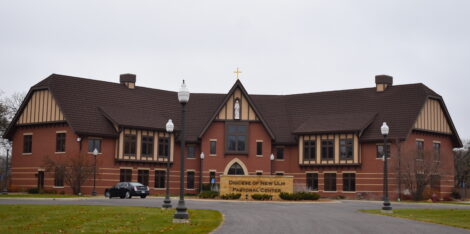Predicting the future among hospital challenges
State legislation would prohibit fees for non-emergency services at provider- based clinics

Staff photo by Fritz Busch Following the retirement of Kevin Sellheim, Todd Consbruck became the new Sleepy Eye Medical Center administrator Jan. 15. Consbruck said some of the biggest challenges of leading a hospital is predicting the future.
SLEEPY EYE — Sleepy Eye Medical Center was listed on the Minnesota Department of Health’s latest “distressed” community hospital list of facilities that lost money on operations in four of the last eight years. Sleepy Eye Medical Center had a -0.5% Fiscal Year 2023 operating margin.
Sleepy Eye Medical Center Administrator Todd Consbruck says his facility is not unlike other hospitals these days facing a number of challenges.
“We’re like all hospitals. Probably our biggest challenge is predicting the future. What will our budgets look like? What vaccinations will be need. How would possible Medicaid cuts impact what we need to do? Since the end of COVID, we’re recreating health care,” he said.
Consbruck said everything starts with the medical staff.
“We’re fortunate to have a wonderful medical staff,” he said.
Consbruck said he’s thankful for traveling nurses that help fill out staff.
“God bless ’em. Where would we and nursing homes be without them? We have three traveling nurses out of 30 nurses. Pretty soon, we’ll be down to two. One of them has been coming here for two and one-half years. I’ve had very good luck with traveling nurses from the Philippines and other foreign countries at hospitals I’ve worked at. We rely on these folks and couldn’t operate without them. We need people with talent, wherever they are from,” he said.
“It’s always tough to stay ahead. We’re focusing on the now. We brought young kids in for tours. We’re working on a local academy so kids can get credits and some of their licensing. It will help us, nursing homes and introduce medical careers to kids.”
Consbruck said he’s impressed by the way the city-owned, non-profit hospital works with patients and their families to give them what’s best for healthcare.
“We find out what care they need and what hospital they should go to. I’m proud of the fact we make local decisions. Our board is local, which is kinda unheard of. We’re focused on operations and blessed with money that was put away. We’re not out to have huge bottom (profit) lines or anything like that,” he said.
Consbruck said he’s also proud that Sleepy Eye Medical Center continues to deliver babies.
Thanks to the 2024 Spirit of Giving Gala that raised $187,000 last fall, the medical center added two EKG machines, a stress test system, enhanced cardiac rehabilitation software and technology upgrades to diagnose and monitor heart conditions.
“The most amazing thing is how the community supports us. We even got donations from people after they heard about us raising money for the equipment. That’s what drives me as an administrator,” he said.
Budget figures for 2024 are not final yet, but Consbruck said the medical center had a slight operational loss in 2024 but finished above water thanks to investment income. He said the 2025 budget is out of the red so far with $289,423 in operating income and $101,198 in non-operating income for a total of $390,621 as part of a $13 million budget this year.
Other rural Minnesota hospitals on the distressed community hospital list include those in Madelia, Worthington, Fairmont, Dawson and Appleton. Mayo Clinic Health System announced the closure of delivery and surgical services in Fairmont last fall. The main reason for the closures was a significant shortage of obstetricians and physicians in the area despite recruitment efforts.
Consbruck said the Minnesota legislature is considering a bills (SF 2669, HF 1312) that would prohibit facility fees for non-emergency medical services at provider-based clinics and pose a $1.2 billion cut to non-profit hospitals already struggling with reimbursement shortfalls, rising operation costs and workforce pressures. Facility fees have been recognized by federal policy as essential payments that help hospitals pay for caregivers and staff, infrastructure, technology, and maintenance–critical resources, according to the Minnesota Hospital Association (MHA).
Eliminating the ability to bill for these costs would accelerate clinic and outpatient service closures statewide, resulting in patient loss of access to care and places non-profit hospitals are a significant disadvantage, according to the MHA.
“This bill may be well meant, but I feel it’s a misunderstanding,” said Consbruck.





